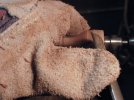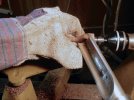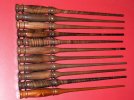I have to start production turning a 3/8" spindle, turned down from 5/8" and 12" long.
Normally I'd do something like this with a skew. I'll sharpen it on a 120 grit belt, which I find to be more than adequate in most cases. 3000 rpm.
Normally, a spindle that thin will produce a lot of chatter, and it's difficult to get the spindle straight and true. The far end will wobble all over.
I've been futzing with a sharper skew at a slower head speed. Sharpen the skew to 220-400 grit. Slow the head speed to > 1000rpm. The slower head speed will need a sharper tool. Initial test work shows far less chatter, better control, and the sharper skew peels finer and easier.
Has anybody else tried this? What did you find out?
Normally I'd do something like this with a skew. I'll sharpen it on a 120 grit belt, which I find to be more than adequate in most cases. 3000 rpm.
Normally, a spindle that thin will produce a lot of chatter, and it's difficult to get the spindle straight and true. The far end will wobble all over.
I've been futzing with a sharper skew at a slower head speed. Sharpen the skew to 220-400 grit. Slow the head speed to > 1000rpm. The slower head speed will need a sharper tool. Initial test work shows far less chatter, better control, and the sharper skew peels finer and easier.
Has anybody else tried this? What did you find out?
Last edited:



